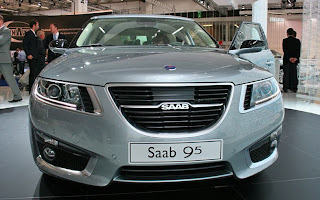 |
| 2010 Saab 9-5 |
Roughly a month after photos of it were unceremoniously leaked onto the Web, official details of the all-new 2010 Saab 9-5 have finally been released in advance of its debut on the big stage at the 2009 Frankfurt auto show.
The 9-5 arrives at a critical time for the struggling Scandinavian automaker, which is in the process of being purchased from General Motors by Swedish boutique brand Koenigsegg. In an interesting twist, the 9-5's details were released at the GM media site. GM of course has provided some of the technology underpinning the new 9-5, most notably the automaker's Epsilon II front-drive based platform, which is also employed on the Opel Insignia and Buick LaCrosse.
"This car is the start of a new era for our brand," says Jan Ake Jonsson, Saab Automobile's Managing Director, in a press release announcing the car. "We have created an advanced and very distinctive product by leveraging the power of our roots in key areas, such as progressive Scandinavian design, sporty driving and responsible performance. The new 9-5 delivers in all these respects, as will every future product from Saab."
The new 9-5 strikes quite a pose form a design standpoint, with several cues taken from its acclaimed Aero X concept vehicle and, of course, its well-worn aircraft heritage. It's a muscular, low-slung and substantial-looking vehicle. Saab said it went with more of traditional three-box design at the 9-5's core, eschewing the four-door coupe craze that's been sweeping sedan design.
At the front, what Saab refers to as 'ice block' headlamps sweep back slightly into the fenders, with substantial inlets housing foglamps on each end of the lower front fascia, and a slatted, Saab-badged grille that takes on a bowl-like proportion. The greenhouse features blacked out pillars to give it a mono graphic appearance, with basic proportions that Saab says echoes its classic 900.
A hockey stick beltline, a strong C-pillar and fenders designed to 'melt' into the wheels are other notable features, as is another 'ice block' light bar that runs the length of the trunk. Look closely at the rear of the car, and there's a noticeable hatchback silhouette, another nod to Saab's past. Attractive, dual trapezoidal exhaust tips are also part of the package.
Powering the new 9-5 is a range of engines highlighted by Saab's signature turbocharged heritage. At launch, the 9-5 will be available with a 160-hp, 2.0-liter turbodiesel and 2.0-liter turbo gas mill with 220 hp on tap. The range-topping engine is a 2.8-liter turbocharged V-6 producing 300 horsepower (also found in the Cadillac SRX) which will be mated exclusively to the automaker's XWD all-wheel-drive system.
Just after launch, a 1.6-liter gas-powered turbo with 180 hp will be offered, as will Saab's 2.0-liter BioPower E85-capable engine. Every engine option will be mated to a six-speed transmission. Saab was not clear in its release if both six-speed manual and automatic will be offered, but we suspect so. For the U.S. market, expect the 2.8-liter and the 2.0-liter turbo to be the only options offered at launch.
The 9-5 also features several top flight technologies designed to both improve the car's handling as well as driver engagement and comfort. Saab's XWD system will be offered on the 2.0-liter gas, BioPower and 2.8 V-6. Also available is an adaptive chassis option that allows drivers to select a range of settings through Saab's DriveSense system, which boasts real time damping control. Two Suspension layouts have been tuned specifically depending on engine power, and both are available with a sport chassis setup.
Other tech features available for the 9-5 include an aircraft style heads up display Saab calls Pilot HUD; adaptive Bi-Xenon lighting and cruise control; keyless entry and start; dynamic parking assistance and tri-zone A/C.
Inside the all-new cabin layout, the 9-5's dimensions have been increased, particularly in the leg and shoulder room areas. The gauge work is an evolution of the automaker's jet-themed approach featuring an 'altimeter'-speed readout and the optional Pilot HUD display bathed in the brand's signature green lighting. Saabphiles will get a kick out of the start/stop button, which is located between the front seats next to the gear shift -- where it should be.
The 9-5 comes with a slew of other premium interior touches and options befitting of the car's new mission, including a Harmon/Kardon audio system; 8-in. touchscreen navigation; connections for portable devices and 12-volt power outlet and rear seat entertainment.
Available in Linear, Vector or Aero trims, the new 9-5 will be built at Saab's home plant in Trollhattan, where the automaker claims it has been engineered and chiefly developed. It's OK Saab, you can say GM helped.
We'll have more on the new 9-5 during its unveiling at Frankfurt, where we should get a sense of U.S.-market timing and availability. But from the looks of it so far, Koenigsegg has bought into Saab at just the right time.
2010 Saab 9-5
2010 Saab 9-5
2010 Saab 9-5























































